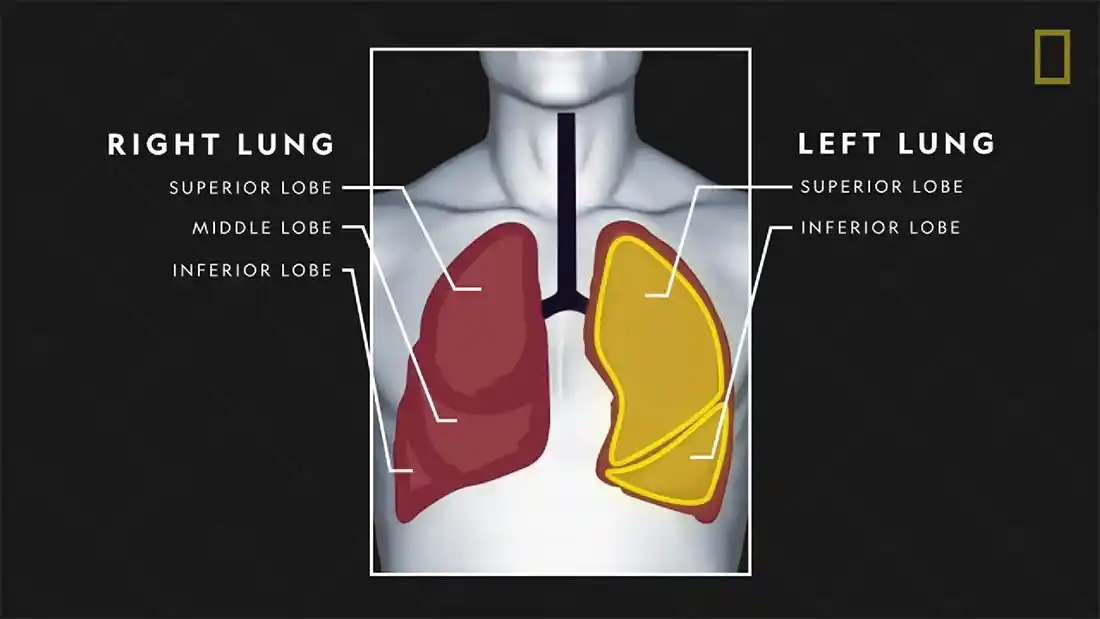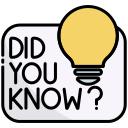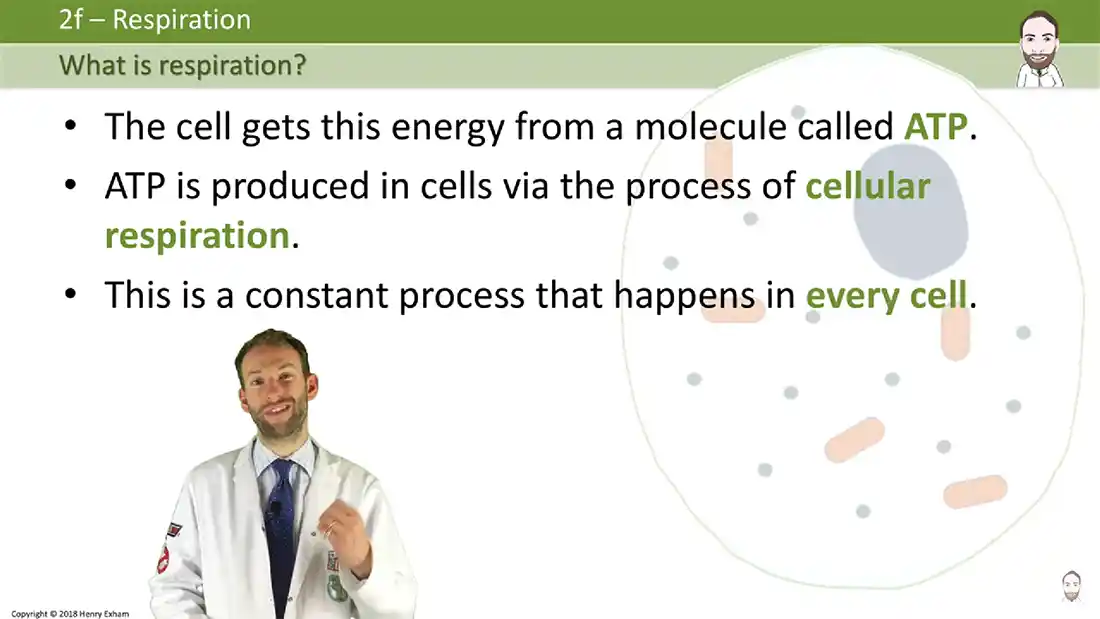

Respiratory system, lungs, air, breathing, villi, bronchioles, alveoli, deoxygenated, oxygenated, blood, 3-lobed, bi-lobed, carbon dioxide, energy, glucose, water, aerobic, anaerobic, respiration, oxygen debt.
We've all got to breathe. Look, you're doing it now. And you've just realised that you are and that you are regulating it while reading this. This is an automatic response. Please leave a message after the tone, and we will... I'm kidding. But that is an automatic function that we don't realise we are doing until someone points it out.
Well, there are a few parts of our body that are linked with the respiratory system. They include:
Both different sizes, due to the fact that there are other organs within the ribcage, the lungs are made up of areas called lobes. Your left lung is smaller than your right lung, due to needing space for your heart. The lungs are made up of muscle tissue that allow for expansion and contraction for when we breathe.
So, how does it work?
Our brain automatically tells us to breathe in, and breathe out. Look, you're doing it again. No? Right, enough of that then.
We are on an autopilot when it comes to breathing and our blood flow. The breathing interacts with the circulatory system, and likewise the other way. For it to function properly, they need to work together.
When the lungs fill with air, they quickly process the oxygen in the air to get ready for deoxygenated blood to take it on. Then when we breathe out, we exhale the carbon dioxide and other waste gases from our body as a result.
Inside our lungs, we have small airway 'tubes' that are covered with mucus. This is a good thing, as this mucus helps to trap the dirt and germs in the air as we breathe in. This is then moved away from the lungs by small, hairlike structures called cilia. They move the dirty mucus away from the bronchioles, which are the smaller tubes in your lungs. A condition called Cystic Fibrosis is a genetic disease that stops this from happening.
The following still is from a video on the lungs, with the following details:
Please click on the image to view the video.


The right lung is 3-lobed and the left lung is bi-lobed. This is because the left lung sits in front of the heart, making it slightly smaller. It is an evolutionary change that enables all our organs to fit inside our body.
Situated directly below the lungs, the diaphragm is a domed sheet of muscle that contracts and expands to allow us to breathe in and breathe out, respectively. Without this, the lungs would not be able to function properly, and can cause conditions of illness to arise.
Alveoli are inside the lungs. They are at the end of the bronchials, which are the pipes within the lungs transporting oxygen and other gases when we breathe. The alveoli serve to process oxygen to the circulatory system. They store the oxygen and allow it to be taken by haemoglobinSituated within red blood cells. that are deoxygenated.
This is a process that happens when we breathe. To make energy, we need oxygen to help our body process it. Looking at the respiration equation, we know that we use glucose and oxygen to give out carbon dioxide and water. This then results in the production of energy.
Our glucose comes from the food in our diet, whereas the oxygen is taken from when we breathe in. Then when we breathe out, we also breathe out tiny droplets of water along with the carbon dioxide.
There's a word equation for respiration. You know that when you breathe in, you don't just breathe in oxygen, and also that you don't just breathe out carbon dioxide. So, there's an equation for what happens when you do breathe.

Glucose + Oxygen  Carbon Dioxide + Water (+ Energy)
Carbon Dioxide + Water (+ Energy)
The end result is that you produce energy from this as well. For the actual formula of the equation, it is:

C6H12O6 + 6O2  6H2O + 6CO2 (+ ENERGY)
6H2O + 6CO2 (+ ENERGY)
When we can't breathe in enough air allowing for aerobic respiration, our body turns to anaerobic respiration, which doesn't need oxygen to create energy. Instead, it uses glucose from the food we eat, and turns it into energy. However, this is not as much energy as we continually need, and it also produces a lot of lactic acid, which, given enough of can then harm our body if it is not removed quickly.
The word equation for anaerobic respiration is:

Glucose  Lactic Acid + Energy
Lactic Acid + Energy
Alternatively, the symbol equation for anaerobic respiration is:

C6H12O6  2C3H603 + Energy
2C3H603 + Energy
The following still is from a video on the respiration, with the following details:
Please click on the image to view the video.

So, you've been working hard, and you've done a lot of anaerobic respiration. As a result, you need to recoup some of the oxygen your body has lost. This is known as oxygen debt. To recoup it, you need to breathe in and out larger and quicker breaths than normal so that more oxygen can be restored to the places that need it. This will then recover to a more normal form of breathing, and will also stop the build-up of lactic acid that is created through anaerobic respiration, which is also known as cellular respiration.
Try and answer the following questions without looking first:
The gills. Because fish spend most of their time underwater, they need a system that allows them to convert oxygen from the water.
Aerobic respiration uses oxygen to create masses of energy, while anaerobic respiration doesn't, and creates less energy. It also creates lactic acid, which, if too much is created, can lead to fatality.
In the alveoli. They are small sacs surrounded by capillaries that allow for oxygen to be exchanged with carbon dioxide in blood cells.
Activities to be used in the classroom.

If you are unable to see the board, please click here.
 Breathe in, Breathe Out Activity
Breathe in, Breathe Out Activity
Lung diseases are not uncommon. Some can be treated and you can make a good recovery, while others are more serious, and can be fatal. Let's have a look at some of them.
This is something that can be caused naturally, or also through excessive smoking. Actually, even if you smoke one cigarette, you increase your chances of getting it, so don't do it.
Cancer is the mutation of cells within the lungs. This can also happen with any of the cells in your body, and can cause other cancers to appear. A cancer in the lungs can be either benign or malignant; benign means that it will just be sat in one place, whereas malignant tumours can spread to other places in your body.
A condition that can develop quickly over 24 to 48 hours, and common symptoms include difficulty breathing, high temperature, rapid heartbeat, sweating or shivers, and loss of appetite. It is swelling of the tissue in one or both lungs.
Pneumonia can be recovered from between two to four weeks, however it affects some people differently, and babies, the elderly and people with heart or lung conditions are at risk of getting seriously ill and may need a visit to the hospital or further treatment to recover from it.
This is a narrowing or complete blockage of the bronchials. It is common with excessive smokers, and is also linked to Asthmatics.
It is a collective name for a variety of conditions, including emphysemadamage to the air sacs in the lungs and chronic bronchitislong-term inflammation of the airways. COPD occurs primarily in later life, and most people who have it are unaware that they do.
A lung condition that limits the airways in your system. It can be controlled, and children can also grow out of it in adult life. It is controlled by inhalers or ventilators.
The main types of treatment for asthma, which has no cure, include inhalers for relief, inhalers for prevention, and a device called a nebuliser, which pumps the drug into your system through breathing and a mask. Some people who have had asthma as a child can get the condition again later in life, and it may be more prevalent, whereas others don't get it at all again. There are many reasons why you can get asthma, including allergies to dust, pollen or animals, smoke and pollution in the air, exercise, and if you're already ill with a cold or flu.
This is a genetic condition passed down from parent to child, so although it is not something you can 'catch', it is a serious lung condition that restricts what you can do. People with this condition will usually need a lung transplant (or two!), but it can be controlled and lived with if given the right conditions.
Alpha-1 antitrypsin (A1AT) is a protein created in the liver, and passed through the bloodstream to the lungs, where it provides protection to the lungs from other molecules such as enzymes, which break down proteins. A deficiency in this (called AAT - Alpha-1 Antitrypsin), is created due to an abnormal Chromosome - number 14 to be exact - which is mis-shaped. Due to this reason, it doesn't leave the liver as it the wrong shape, and it then can't pass to the bloodstream. This then gives them the deficiency of A1AT.
Disclaimer | About Me | Sitemap
Website design by SyntaxHTML.



Blue icons adapted from icons courtesy of Smashicons.com